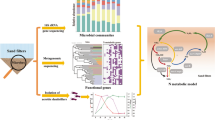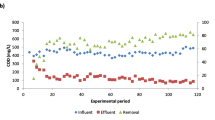Abstract
Biological aerated filters (BAFs) were constructed and operated for assessing the effectiveness of bacterial community bioaugmented by a yeast Magnusiomyces ingens LH-F1 for treatment of azo dye Acid Red B (ARB). Dynamics of both bacterial and fungal communities were analyzed through MiSeq sequencing method. The results showed that the bioaugmented BAF displayed obviously better performance for decolorization, COD removal and detoxification of ARB wastewater than the other two which were inoculated with activated sludge (AS) and single M. ingens LH-F1, respectively. Moreover, the bioaugmented BAF also exhibited higher tolerance and stability to shock loading. MiSeq sequencing results demonstrated that both of bacterial and fungal communities remarkably shifted with operation conditions, and the increasing fungal diversity in the bioaugmented BAF was probably related to the relatively high biodegradation and detoxification efficiency. Furthermore, M. ingens LH-F1 survived in the bioaugmented BAF and became one of the dominant fungal species. Therefore, bioaugmentation with yeast M. ingens LH-F1 was successful for improving traditional biological processes aiming at treatment of azo compounds. This method was also potentially useful and meaningful for treating other recalcitrant organic pollutants in practical applications.






Similar content being viewed by others
References
Aksu Z, Kılıç NK, Ertuğrul S, Dönmez G (2007) Inhibitory effects of chromium(VI) and Remazol Black B on chromium(VI) and dyestuff removals by Trametes versicolor. Enzyme Microb Technol 40:1167–1174. doi:10.1016/j.enzmictec.2006.08.024
Al Kharusi S, Abed RM, Dobretsov S (2016) EDTA addition enhances bacterial respiration activities and hydrocarbon degradation in bioaugmented and non-bioaugmented oil-contaminated desert soils. Chemosphere 147:279–286. doi:10.1016/j.chemosphere.2015.12.114
Cassa-Barbosa LA, Procópio RE, Matos IT, Filho SA (2015) Isolation and characterization of yeasts capable of efficient utilization of hemicellulosic hydrolyzate as the carbon source. Genet Mol Res 14:11605–11612. doi:10.4238/2015.September.28.12
Chen Y, Zhang Y, Zhang Q, Xu L, Li R, Luo X, Zhang X, Tong J (2015) Earthworms modify microbial community structure and accelerate maize stover decomposition during vermicomposting. Environ Sci Pollut Res 22:17161–17170. doi:10.1007/s11356-015-4955-z
Cui D, Li G, Zhao D, Gu X, Wang C, Zhao M (2012) Microbial community structures in mixed bacterial consortia for azo dye treatment under aerobic and anaerobic conditions. J Hazard Mater 221–222:185–192. doi:10.1016/j.jhazmat.2012.04.032
Dhouib A, Ellouz M, Aloui F, Sayadi S (2006) Effect of bioaugmentation of activated sludge with white-rot fungi on olive mill wastewater detoxification. Lett Appl Microbiol 42:405–411. doi:10.1111/j.1472-765X.2006.01858.x
Gargouri B, Mhiri N, Karray F, Aloui F, Sayadi S (2015) Isolation and characterization of hydrocarbon-degrading yeast strains from petroleum contaminated industrial wastewater. Biomed Res Int 2015:1–11. doi:10.1155/2015/929424
Gou M, Qu Y, Zhou J, Ma F, Tan L (2009) Azo dye decolorization by a new fungal isolate, Penicillium sp. QQ and fungal-bacterial cocultures. J Hazard Mater 170:314–319. doi:10.1016/j.jhazmat.2009.04.094
Hadibarata T, Adnan LA, Yusoff ARM, Yuniarto A, Rubiyatno, Zubir MMFA, Khudhair AB, Teh ZC, Naser MA (2013) Microbial decolorization of an azo dye Reactive Black 5 using white-rot fungus Pleurotus eryngii F032. Water Air Soil Pollut 224:1–9. doi:10.1007/s11270-013-1595-0
Hong Y, Xu M, Guo J, Xu Z, Chen X, Sun G (2007) Respiration and growth of Shewanella decolorationis S12 with an azo compound as the sole electron acceptor. Appl Environ Microbiol 73:64–72. doi:10.1128/AEM.01415-06
Jiang Y, Wei L, Zhang H, Yang K, Wang H (2016) Removal performance and microbial communities in a sequencing batch reactor treating hypersaline phenol-laden wastewater. Biores Technol 218:146–152. doi:10.1016/j.biortech.2016.06.055
Jin D, Kong X, Li Y, Bai Z, Zhuang G, Zhuang X, Deng Y (2015) Biodegradation of di-n-butyl phthalate by Achromobacter sp. isolated from rural domestic wastewater. Int J Environ Res Public Health 12:13510–13522. doi:10.3390/ijerph121013510
Köchling T, Ferraz AD Jr, Florencio L, Kato MT, Gavazza S (2016) 454-Pyrosequencing analysis of highly adapted azo dye-degrading microbial communities in a two-stage anaerobic-aerobic bioreactor treating textile effluent. Environ Technol 22:1–7. doi:10.1080/09593330.2016.1208681
Kowalczyk A, Chyc M, Ryszka P, Latowski D (2016) Achromobacter xylosoxidans as a new microorganism strain colonizing high-density polyethylene as a key step to its biodegradation. Environ Sci Pollut Res 23:11349–11356. doi:10.1007/s11356-016-6563-y
Kües U (2015) Fungal enzymes for environmental management. Curr Opin Biotechnol 33:268–278. doi:10.1016/j.copbio.2015.03.006
Kumari L, Tiwary D, Mishra PK (2016) Biodegradation of C.I. Acid Red 1 by indigenous bacteria Stenotrophomonas sp. BHUSSp X2 isolated from dye contaminated soil. Environ Sci Pollut Res 23:4054–4062. doi:10.1007/s11356-015-4351-8
Lade HS, Waghmode TR, Kadam AA, Govindwar SP (2012) Enhanced biodegradation and detoxification of disperse azo dye Rubine GFL and textile industry effluent by defined fungal-bacterial consortium. Int Biodeterior Biodegradation 72:94–107. doi:10.1016/j.ibiod.2012.06.001
Li H, Tan L, Ning SX, He MY (2015) Reactor performance and microbial community dynamics during aerobic degradation and detoxification of Acid Red B with activated sludge bioaugmented by a yeast Candida tropicalis TL-F1 in MBR. Int Biodeterior Biodegradation 104:149–156. doi:10.1016/j.ibiod.2015.06.006
Ma J, Wang Z, Yang Y, Mei X, Wu Z (2013) Correlating microbial community structure and composition with aeration intensity in submerged membrane bioreactors by 454 high-throughput pyrosequencing. Water Res 47:859–869. doi:10.1016/j.watres.2012.11.013
Miran W, Nawaz M, Kadam A, Shin S, Heo J, Jang J, Lee DS (2015) Microbial community structure in a dual chamber microbial fuel cell fed with brewery waste for azo dye degradation and electricity generation. Environ Sci Pollut Res 22:13477–13485. doi:10.1007/s11356-015-4582-8
Neoh CH, Lam CY, Lim CK, Yahya A, Bay HH, Ibrahim Z, Noor ZZ (2015) Biodecolorization of recalcitrant dye as the sole source of nutrition using Curvularia clavata NZ2 and decolorization ability of its crude enzymes. Environ Sci Pollut Res 22:11669–11678. doi:10.1007/s11356-015-4436-4
Novotný C, Svobodová K, Benada O, Kofroňová O, Heissenberger A, Fuchs W (2011) Potential of combined fungal and bacterial treatment for color removal in textile wastewater. Biores Technol 102:879–888. doi:10.1016/j.biortech.2010.09.014
Podorozhko EA, Lozinsky VI, Ivshina IB, Kuyukina MS, Krivorutchko AB, Philp JC, Cunningham CJ (2008) Hydrophobised sawdust as a carrier for immobilisation of the hydrocarbon-oxidizing bacterium Rhodococcus rubber. Biores Technol 99:2001–2008. doi:10.1016/j.biortech.2007.03.024
Qu YY, Zhou JT, Wang J, Xing LL, Jiang N, Gou M, Salah Uddin M (2009) Population dynamics in bioaugmented membrane bioreactor for treatment of bromoamine acid wastewater. Biores Technol 100:244–248. doi:10.1016/j.biortech.2008.06.023
Qu Y, Shi S, Ma F, Yan B (2010) Decolorization of reactive dark blue K-R by the synergism of fungus and bacterium using response surface methodology. Biores Technol 101:8016–8023. doi:10.1016/j.biortech.2010.05.025
Qu Y, Cao X, Ma Q, Shi S, Tan L, Li X, Zhou H, Zhang X, Zhou J (2012) Aerobic decolorization and degradation of Acid Red B by a newly isolated Pichia sp. TCL. J Hazard Mater 223–224:31–38. doi:10.1016/j.jhazmat.2012.04.034
Saratale RG, Gandhi SS, Purankar MV, Kurade MB, Govindwar SP, Oh SE, Saratale GD (2013) Decolorization and detoxification of sulfonated azo dye C.I. Remazol Red and textile effluent by isolated Lysinibacillus sp. RGS. J Biosci Bioeng 115:658–667. doi:10.1016/j.jbiosc.2012.12.009
Sarioglu M, Bali U, Bisgin T (2007) The removal of C.I. Basic Red 46 in a mixed methanogenic anaerobic culture. Dyes Pigm 74:223–229. doi:10.1016/j.dyepig.2006.02.001
Shen J, He R, Yu H, Wang L, Zhang J, Sun X, Li J, Han W, Xu L (2009) Biodegradation of 2,4,6-trinitrophenol (picric acid) in a biological aerated filter (BAF). Biores Technol 100:1922–1930. doi:10.1016/j.biortech.2008.10.018
Shi S, Qu Y, Ma Q, Zhang X, Zhou J, Ma F (2015) Performance and microbial community dynamics in bioaugmented aerated filter reactor treating with coking wastewater. Biores Technol 190:159–166. doi:10.1016/j.biortech.2015.04.075
Singh K, Arora S (2011) Removal of synthetic textile dyes from wastewaters: a critical review on present treatment technologies. Crit Rev. Environ Sci Technol 41:807–878. doi:10.1080/10643380903218376
Singh RL, Singh PK, Singh RP (2015) Enzymatic decolorization and degradation of azo dyes: a review. Int Biodeterior Biodegradation 104:21–31. doi:10.1016/j.ibiod.2015.04.027
Su WT, Lin CH (2013) Fungal-bacterial synergism enhanced decolorization of reactive red 120 by response surface methodology. Int Biodeterior Biodegradation 82:1–8. doi:10.1016/j.ibiod.2013.02.008
Tan L, Ning S, Xia H, Sun J (2013a) Aerobic decolorization and mineralization of azo dyes by a microbial community in the absence of an external carbon source. Int Biodeterior Biodegradation 85:210–216. doi:10.1016/j.ibiod.2013.02.018
Tan L, Ning S, Zhang X, Shi S (2013b) Aerobic decolorization and degradation of azo dyes by growing cells of a newly isolated yeast Candida tropicalis TL-F1. Biores Technol 138:307–313. doi:10.1016/j.biortech.2013.03.183
Tan L, Li H, Ning S, Hao J (2014a) Aerobic decolorization and degradation of Acid Orange G (AOG) by suspended growing cells and immobilized cells of a yeast strain Candida tropicalis TL-F1. Biores Technol 174:1651–1667. doi:10.1007/s12010-014-1086-9
Tan L, Li H, Ning S, Xu B (2014b) Aerobic decolorization and degradation of azo dyes by suspended growing cells and immobilized cells of a newly isolated yeast Magnusiomyces ingens LH-F1. Biores Technol 158:321–328. doi:10.1016/j.biortech.2014.02.063
Tan L, He M, Song L, Fu X, Shi S (2016) Aerobic decolorization, degradation and detoxification of azo dyes by a newly isolated salt-tolerant yeast Scheffersomyces spartinae TLHS-SF1. Biores Technol 203:287–294. doi:10.1016/j.biortech.2015.12.058
Waghmode TR, Kurade MB, Lade HS, Govindwar SP (2012) Decolorization and biodegradation of Rubine GFL by microbial consortium GG-BL in sequential aerobic/microaerophilic process. Appl Biochem Biotechnol 167:1578–1594. doi:10.1007/s12010-012-9585-z
Xiong L, Huang C, Li XM, Chen XF, Wang B, Wang C, Zeng XA, Chen XD (2015) Acetone-butanol-ethanol (ABE) fermentation wastewater treatment by oleaginous yeast Trichosporon cutaneum. Appl Biochem Biotechnol 176:563–571. doi:10.1007/s12010-015-1595-1
Zou XL (2015) Treatment of heavy oil wastewater by UASB-BAFs using the combination of yeast and bacteria. Environ Technol 36:2381–2389. doi:10.1080/09593330.2015.1030346
Acknowledgements
This work was financially supported by the National Natural Science Foundation of China (Nos. 51108223 and 51508259).
Author information
Authors and Affiliations
Corresponding author
Rights and permissions
About this article
Cite this article
He, M., Tan, L., Ning, S. et al. Performance of the biological aerated filter bioaugmented by a yeast Magnusiomyces ingens LH-F1 for treatment of Acid Red B and microbial community dynamics. World J Microbiol Biotechnol 33, 39 (2017). https://doi.org/10.1007/s11274-017-2210-0
Received:
Accepted:
Published:
DOI: https://doi.org/10.1007/s11274-017-2210-0




